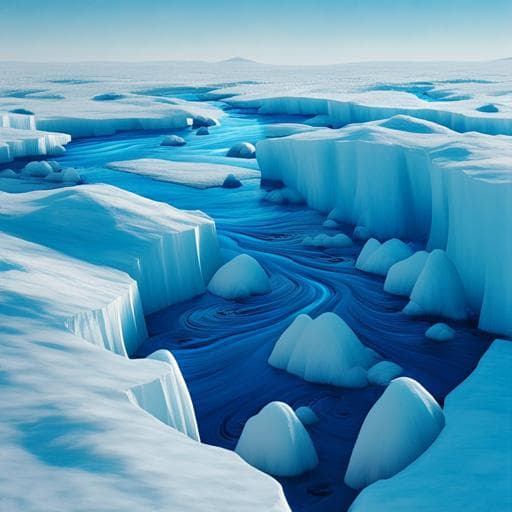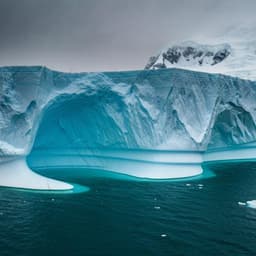
Earth Sciences
Higher Antarctic ice sheet accumulation and surface melt rates revealed at 2 km resolution
B. Noël, J. M. V. Wessem, et al.
Discover groundbreaking insights into Antarctic ice sheet mass loss, driven by increased ice discharge and influenced by surface processes. This study by Brice Noël, J. Melchior van Wessem, Bert Wouters, Luke Trusel, Stef Lhermitte, and Michiel R. van den Broeke unveils a significant rise in surface melt rates and presents enhanced SMB data, revolutionizing our understanding of ice dynamics until the end of the century.
~3 min • Beginner • English
Introduction
The Antarctic Ice Sheet is losing mass because solid ice discharge (ice shelf basal melt and calving) exceeds surface inputs, while the temporal variability of mass change is primarily controlled by surface mass balance (SMB) processes. Over ice shelves, surface melt lowers the surface, depletes firn pore space, promotes ponding and drainage, and can trigger hydrofracture and collapse, reducing buttressing and accelerating grounded ice discharge. As atmospheric warming increases, Antarctic ice shelves are expected to become more susceptible to melt-driven instability. However, regional and Earth system models typically run at coarse spatial resolutions (25–100 km) that cannot resolve complex Antarctic topography (e.g., Antarctic Peninsula, Transantarctic Mountains, Queen Maud Land), leading to biases in snowfall and melt gradients. The study aims to produce daily SMB and surface melt fields at 2 km resolution for Antarctica, for both the modern period and future warming scenarios, to better capture accumulation and melt patterns—particularly near grounding lines—and to reconcile modeled mass change with satellite observations.
Literature Review
Previous work shows that Antarctic mass balance variability is driven by SMB processes and that surface hydrology can influence ice shelf stability (e.g., hydrofracture following meltwater ponding). Multi-model intercomparisons highlight substantial SMB differences linked to model grid resolution. Earlier RACMO2.3p2 simulations at 27 km resolution underestimate melt compared to AWS and QuikSCAT satellite records. Statistical downscaling has proven effective in Greenland and other Arctic regions to refine SMB and melt spatial variability at sub-kilometer scales, improving agreement with observations and mass change estimates, suggesting similar benefits for Antarctica. Model-based projections indicate increasing surface melt with warming and vulnerability of ice shelves to collapse under future climates.
Methodology
Core modeling: The polar Regional Atmospheric Climate Model version 2.3p2 (RACMO2.3p2) at 27 km resolution was forced by ERA5 reanalysis (1979–2021) for contemporary climate and by CESM2 (historical 1950–2014, projections 2015–2099 under SSP1-2.6, SSP2-4.5, SSP5-8.5) for future scenarios. RACMO2.3p2 includes a 40-layer snow module for melt, percolation, retention/refreezing and runoff, and simulates dry-snow densification, drifting snow, and grain-size–based albedo. Boundary conditions were applied via a relaxation zone, with prescribed sea ice and SSTs consistent with forcing data. Firn was initialized from IMAU-FDM; ice albedo was fixed at 0.55; topography derived from a 1 km DEM downsampled to 27 km. Ice mask and topography remained fixed (no interactive ice dynamics).
Statistical downscaling to 2 km: RACMO outputs (SMB components: total precipitation PR, sublimation SU, drifting snow erosion ER, melt ME, runoff RU) were statistically downscaled from 27 km to a 2 km grid using the REMA DEM and a compiled 2 km ice mask (IMBIE-2 grounded AIS, Bedmap2 ice shelves, RGIv6 sub-Antarctic glaciers). Daily, local vertical gradients of each component were computed on the 27 km grid using linear regressions over at least six neighboring cells. The regression slope and intercept were bilinearly interpolated to the 2 km grid and applied to the high-resolution elevation via X2km = a2km h2km + b2km. Melt and runoff received additional spatial corrections for low-albedo (blue/bare ice) areas using a 2 km MODIS albedo climatology (2000–2021) accounting for solar zenith angle, slope, and aspect. When too few 27 km cells exhibited runoff on a given day, runoff was bilinearly interpolated to 2 km for spatial continuity. Snowfall fraction (SFfrac) was downscaled and snowfall estimated as SF2km = PR2km × SFfrac2km; rainfall as RA2km = PR2km − SF2km. SMB was reconstructed as SMB2km = PR2km − RU2km − SU2km − ER2km; refreezing as RF2km = ME2km + RA2km − RU2km. The method is not strictly mass-conservative but improves spatial fidelity of components.
Evaluation and mass change: SMB evaluation used 14,292 multi-year in situ records from the AntSMB dataset. Melt evaluation used 81 annual records from 10 AWS (1992–2018) and Antarctic-wide point comparisons with QuikSCAT (4.45 km, 2000–2009). Mass change was assessed using the input–output method: model SMB minus solid ice discharge (D) from Rignot et al. (to 2017), with D linearly extrapolated to 2021 (R² = 0.95). Monthly mass changes at both resolutions were compared to GRACE/GRACE-FO solutions (CSR, JPL, GFZ, ITSG), with standard geophysical corrections and basin aggregation. Uncertainties: SMB and melt uncertainties taken as one standard deviation around the mean over 1979–2021; mass change uncertainty combines SMB and D uncertainties. Sectoral analyses were performed for APIS, WAIS, EAIS, floating shelves, and Antarctica-wide.
Key Findings
- Antarctic-wide SMB increases by 72 Gt yr−1 (≈3%) in the 2 km product relative to 27 km for 1979–2021; elevation correction accounts for 49 Gt yr−1 (≈2%) and ice mask differences for 23 Gt yr−1 (≈1%). Most accumulation increase arises from the Antarctic Peninsula (≈31 Gt yr−1), then floating ice shelves (≈27 Gt yr−1), and EAIS (≈16 Gt yr−1); WAIS shows a negligible decrease (~2 Gt yr−1).
- In situ SMB evaluation improves at 2 km (R² = 0.83 vs 0.80; lower bias −6.6 mm w.e.; lower RMSE −9.4 mm w.e.; K–S p < 0.01), indicating statistically significant local improvements.
- Surface melt increases markedly at 2 km: Antarctic-wide melt is higher by 51 Gt yr−1 (≈46%) for 1979–2021. Contributions: elevation correction 38 Gt yr−1 (34%), ice mask refinement 10 Gt yr−1 (9%), albedo correction 3 Gt yr−1 (3%). Melt increases are concentrated near grounding lines and low-lying valleys; local differences reach up to ~500 mm w.e. yr−1.
- Melt evaluation: 2 km product shows reduced bias (−7.9 mm w.e.) versus AWS and reduced bias (−8.3 mm w.e.) and RMSE (−7.2 mm w.e.) versus QuikSCAT (2000–2009), with better performance near grounding lines. Antarctic-wide integrated 2 km melt agrees with QuikSCAT within uncertainties.
- Mass balance: Grounded AIS SMB is ~2180 ± 107 Gt yr−1 (1979–2021) with an insignificant trend (−0.001 ± 0.660 Gt yr−2). Solid ice discharge averages 2220 ± 142 Gt yr−1 (1979–2017) with a significant positive trend of 4.9 ± 0.4 Gt yr−2. Since 2002 the grounded AIS lost 2272 ± 243 Gt, contributing 6.3 ± 0.7 mm to global sea level rise. Sectoral contributions since 2002: APIS −634 ± 61 Gt, WAIS −2930 ± 132 Gt, EAIS +1292 ± 158 Gt.
- Agreement with GRACE/GRACE-FO improves at 2 km: AIS-wide R² = 0.98; sectors 0.96 < R² < 0.99. Bias and RMSE versus GRACE/GRACE-FO are reduced by ~395 Gt at 2 km relative to 27 km.
- Future melt: CESM2-driven RACMO2.3p2 simulations, downscaled to 2 km, indicate persistent underestimation of melt by ~45% at 27 km irrespective of scenario. Historical (1950–2014) melt averages 139 ± 27 Gt yr−1 (2 km) and is consistent with ERA5-forced estimates (167 ± 33 Gt yr−1 for 1979–2014). From 2015–2099, Antarctic-wide melt increases with trends of ~3.5 ± 0.6 Gt yr−1 (SSP1-2.6), ~5.4 ± 0.6 Gt yr−2 (SSP2-4.5), and ~17.4 ± 1.3 Gt yr−2 (SSP5-8.5). By 2090–2099, the increase relative to present-day could be >3-fold (~170 Gt yr−1 under SSP1-2.6) to >10-fold (~525 Gt yr−1 under SSP5-8.5). Relative melt increases are largest over floating ice shelves (~61%) compared to grounded sectors (11–24%).
Discussion
High-resolution (2 km) statistical downscaling refines accumulation and melt patterns, particularly in complex topography and near grounding lines where coarse models overestimate elevations and smooth strong gradients. The modest but robust SMB enhancement (~3% Antarctica-wide) substantially improves input–output mass balance estimates, reconciling modeled mass change with GRACE/GRACE-FO without ad hoc regional trend corrections. The pronounced increase in resolved surface melt (≈46%) at 2 km aligns better with AWS and QuikSCAT data, underscoring the importance of resolving grounding-line processes and narrow valleys for accurate assessment of ice shelf stability. Future projections show that the coarse-resolution underestimate of melt persists, implying prior studies may have underpredicted melt-related risks. The improved melt representation is particularly consequential for diagnosing hydrofracture potential and buttressing loss, thereby refining projections of AIS discharge and sea-level rise.
Conclusion
This study delivers Antarctic SMB and surface melt products at 2 km resolution for 1979–2021 and for multiple warming scenarios to 2100 by statistically downscaling RACMO2.3p2 outputs. The approach modestly increases SMB and substantially increases surface melt relative to 27 km inputs, improving agreement with in situ and satellite observations and reconciling mass balance with GRACE/GRACE-FO. Results reveal persistent, higher melt rates—especially along grounding lines—than previously estimated, with scenario-dependent accelerations through 2100. The 2 km products provide actionable spatial detail to assess ice shelf viability and inform sea-level rise projections. Future work should incorporate fully coupled Earth system simulations including Antarctic ice dynamics and evolving topography/ice masks, and evaluate potential future surface darkening processes to refine melt projections.
Limitations
- Downscaling relies on model-derived local elevation gradients (from RACMO2.3p2/CESM2-forced fields) that may be biased in steep, complex terrain.
- High-resolution topography (REMA), ice sheet/shelf/glacier masks (IMBIE-2, Bedmap2, RGIv6), and MODIS albedo fields carry uncertainties that propagate into the downscaled components.
- RACMO2.3p2 and the CESM2 forcings used do not include interactive Antarctic ice dynamics; ice mask and topography are fixed in time. Real-world retreat/advance and thickness changes would modify circulation, precipitation, and melt patterns (e.g., melt–elevation feedback), so projections are conservative.
- Albedo corrections assume present-day blue ice characteristics and do not include potential future darkening by biological growth or impurity deposition, which could enhance melt.
- The statistical method is not mass-conservative by design; while improving spatial realism of components, it may adjust fluxes relative to native model outputs.
Related Publications
Explore these studies to deepen your understanding of the subject.







